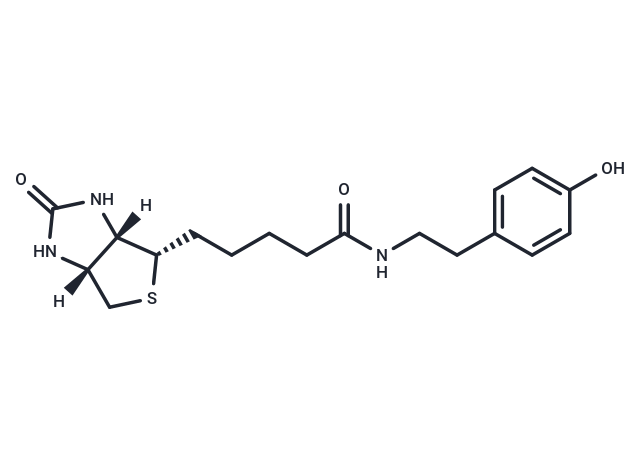Shopping Cart
Remove All Your shopping cart is currently empty
Your shopping cart is currently empty
Biotinyl tyramide, a biotin derivative, is used for tyramide signal amplification, as a reagent to amplify both in situ hybridization and immunohistochemical signals protocols.

| Pack Size | Price | USA Warehouse | Global Warehouse | Quantity |
|---|---|---|---|---|
| 5 mg | $30 | In Stock | In Stock | |
| 10 mg | $40 | In Stock | In Stock | |
| 25 mg | $61 | In Stock | In Stock | |
| 50 mg | $82 | In Stock | In Stock | |
| 100 mg | $121 | In Stock | In Stock | |
| 500 mg | $295 | In Stock | In Stock | |
| 1 mL x 10 mM (in DMSO) | $45 | In Stock | In Stock |
| Description | Biotinyl tyramide, a biotin derivative, is used for tyramide signal amplification, as a reagent to amplify both in situ hybridization and immunohistochemical signals protocols. |
| Cell Research | I. Solution preparation 1. Preparation of stock solution: The common concentration range is 1 μM to 10 μM, and the specific concentration can be optimized according to the sample type, antibody concentration and required signal intensity. 2. Peroxidase solution: HRP-labeled primary antibody (or other peroxidase-labeled antibody) is usually used. Dilute to the appropriate concentration according to the manufacturer's instructions. II. Immunolabeling and color development reaction 1. Antigen retrieval: Depending on the nature of the antigen and the antibody used, an antigen retrieval step (such as heat-induced antigen retrieval, HIER) may be required. 2. Blocking: Block tissue or cell sections with blocking solution to prevent nonspecific binding. 3. Primary antibody incubation: Incubate the sample with the primary antibody labeled with peroxidase. The incubation time is usually 1-2 hours (can be optimized according to the antibody instructions). 4. Secondary antibody incubation (if a secondary antibody is used): Incubate the sample with the secondary antibody labeled with peroxidase, usually for 30-60 minutes. 5. TSA reaction: Add Biotinyl tyramide solution and incubate for 10-30 minutes. TSA reaction requires peroxidase catalysis, so ensure the activity of peroxidase. 6. Labeling and color development: Biotinyl tyramide reacts with HRP to generate biotin, which further binds to avidin-labeled fluorescence or enzyme to produce a detectable signal (such as fluorescence or staining reaction). 7. Washing: After incubation, use washing buffer to remove excess reagents to ensure clear signals. 8. Visualization: Use a microscope to observe the results and stain as needed. Notes: 1. Reaction time: The reaction time of Biotinyl tyramide needs to be optimized according to the peroxidase concentration used and the sample type, usually 10-30 minutes. 2. Optimize concentration: Too high Biotinyl tyramide concentration may cause the signal to be too strong and produce background noise, while low concentration may cause the signal to be too weak. 3. HRP activity: Ensure that the peroxidase-labeled antibody has good activity, otherwise the reaction efficiency may be reduced. |
| Molecular Weight | 363.47 |
| Formula | C18H25N3O3S |
| Cas No. | 41994-02-9 |
| Smiles | C(CCCC(NCCC1=CC=C(O)C=C1)=O)[C@H]2[C@@]3([C@](CS2)(NC(=O)N3)[H])[H] |
| Relative Density. | 1.227 g/cm3 (Predicted) |
| Color | White |
| Appearance | Solid |
| Storage | keep away from direct sunlight | Powder: -20°C for 3 years | In solvent: -80°C for 1 year | Shipping with blue ice/Shipping at ambient temperature. | |||||||||||||||||||||||||||||||||||
| Solubility Information | DMSO: 100 mg/mL (275.13 mM), Sonication is recommended. | |||||||||||||||||||||||||||||||||||
| In Vivo Formulation | 10% DMSO+40% PEG300+5% Tween-80+45% Saline: 3.3 mg/mL (9.08 mM), Sonication is recommeded. Please add the solvents sequentially, clarifying the solution as much as possible before adding the next one. Dissolve by heating and/or sonication if necessary. Working solution is recommended to be prepared and used immediately. The formulation provided above is for reference purposes only. In vivo formulations may vary and should be modified based on specific experimental conditions. | |||||||||||||||||||||||||||||||||||
Solution Preparation Table | ||||||||||||||||||||||||||||||||||||
DMSO
| ||||||||||||||||||||||||||||||||||||
| Size | Quantity | Unit Price | Amount | Operation |
|---|

Copyright © 2015-2025 TargetMol Chemicals Inc. All Rights Reserved.